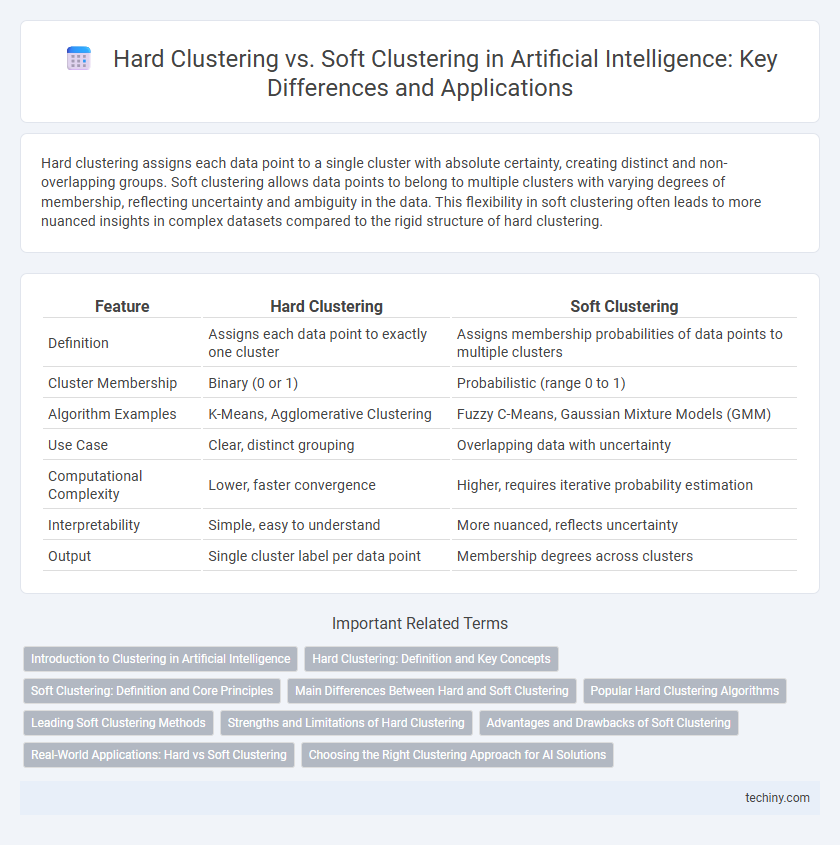Hard clustering assigns each data point to a single cluster with absolute certainty, creating distinct and non-overlapping groups. Soft clustering allows data points to belong to multiple clusters with varying degrees of membership, reflecting uncertainty and ambiguity in the data. This flexibility in soft clustering often leads to more nuanced insights in complex datasets compared to the rigid structure of hard clustering.
Table of Comparison
| Feature | Hard Clustering | Soft Clustering |
|---|---|---|
| Definition | Assigns each data point to exactly one cluster | Assigns membership probabilities of data points to multiple clusters |
| Cluster Membership | Binary (0 or 1) | Probabilistic (range 0 to 1) |
| Algorithm Examples | K-Means, Agglomerative Clustering | Fuzzy C-Means, Gaussian Mixture Models (GMM) |
| Use Case | Clear, distinct grouping | Overlapping data with uncertainty |
| Computational Complexity | Lower, faster convergence | Higher, requires iterative probability estimation |
| Interpretability | Simple, easy to understand | More nuanced, reflects uncertainty |
| Output | Single cluster label per data point | Membership degrees across clusters |
Introduction to Clustering in Artificial Intelligence
Clustering in Artificial Intelligence organizes data into groups based on similarity, enhancing pattern recognition and data analysis. Hard clustering assigns each data point exclusively to one cluster, suitable for clear, distinct group boundaries. Soft clustering allows data points to belong to multiple clusters with varying degrees of membership, improving flexibility in complex or overlapping data distributions.
Hard Clustering: Definition and Key Concepts
Hard clustering assigns each data point exclusively to one cluster based on strict membership criteria, ensuring clear boundaries between groups. Key concepts include the partitioning of data into non-overlapping clusters, where the algorithm assigns a binary label indicating cluster membership. Common algorithms implementing hard clustering are K-means and hierarchical clustering, which optimize cluster centers or tree structures to minimize intra-cluster variance.
Soft Clustering: Definition and Core Principles
Soft clustering is a technique in artificial intelligence where data points can belong to multiple clusters with varying degrees of membership, encapsulated by probabilistic or fuzzy assignments. Core principles include the representation of uncertainty and overlap among clusters, enabling more nuanced data grouping compared to hard clustering's exclusive assignment. Algorithms such as Fuzzy C-Means leverage membership functions to quantify the extent to which each data point belongs to different clusters, improving flexibility in handling complex, real-world data patterns.
Main Differences Between Hard and Soft Clustering
Hard clustering assigns each data point exclusively to one cluster, creating distinct, non-overlapping groups with clear boundaries. Soft clustering allows data points to belong to multiple clusters simultaneously by assigning probability scores, enabling more flexible and nuanced classification. This distinction impacts the choice of algorithms, with K-means representing hard clustering and Gaussian Mixture Models exemplifying soft clustering techniques.
Popular Hard Clustering Algorithms
K-means is the most popular hard clustering algorithm, partitioning data into distinct clusters by minimizing the variance within each cluster. Hierarchical clustering builds a tree of clusters based on data similarity, enabling a clear, non-overlapping cluster structure. DBSCAN identifies clusters through density connectivity, effectively handling noise and discoverable clusters with arbitrary shapes in large datasets.
Leading Soft Clustering Methods
Leading soft clustering methods in artificial intelligence include Gaussian Mixture Models (GMM), fuzzy c-means, and probabilistic latent semantic analysis (PLSA), which assign membership probabilities to data points across clusters. These techniques enhance flexibility in pattern recognition by modeling uncertainty and overlapping cluster boundaries, crucial for applications like natural language processing and image segmentation. Soft clustering methods improve model accuracy in complex datasets by capturing nuanced data relationships better than hard clustering approaches.
Strengths and Limitations of Hard Clustering
Hard clustering assigns each data point exclusively to one cluster, which simplifies interpretation and reduces computational complexity. Its strength lies in clear boundary definitions, making it effective for well-separated datasets, but it struggles with overlapping clusters and complex data structures. Hard clustering's limitation is the inability to express uncertainty or partial membership, often leading to rigid and less flexible models in real-world applications.
Advantages and Drawbacks of Soft Clustering
Soft clustering offers the advantage of assigning data points to multiple clusters with varying degrees of membership, which better captures ambiguity and overlapping categories in complex datasets. This approach enhances interpretability in applications like recommendation systems and natural language processing by reflecting real-world uncertainty. However, soft clustering can be computationally intensive and may require careful tuning of membership thresholds, potentially complicating model scalability and convergence.
Real-World Applications: Hard vs Soft Clustering
Hard clustering assigns each data point exclusively to one cluster, which proves effective in applications like document classification and customer segmentation where discrete groupings are essential. Soft clustering, such as Gaussian Mixture Models, allows data points to belong to multiple clusters with varying probabilities, making it suitable for image recognition, bioinformatics, and recommendation systems where overlapping categories are common. Choosing between hard and soft clustering depends on the complexity of the dataset and the need for nuanced cluster membership in real-world scenarios.
Choosing the Right Clustering Approach for AI Solutions
Hard clustering assigns each data point exclusively to one cluster, making it ideal for applications requiring clear and distinct group boundaries, such as image segmentation in AI vision systems. Soft clustering provides probabilistic membership across multiple clusters, offering nuanced insights for complex datasets like customer behavior analysis in recommendation engines. Selecting between hard and soft clustering depends on the specific AI solution's need for precision versus flexibility in data interpretation.
Hard Clustering vs Soft Clustering Infographic

 techiny.com
techiny.com